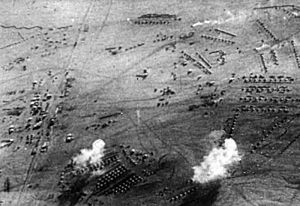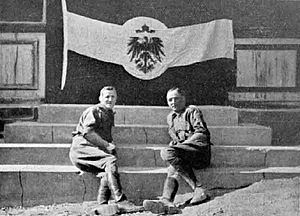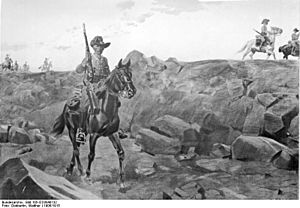South West Africa campaign facts for kids
Quick facts for kids South West Africa campaign |
|||||||||
|---|---|---|---|---|---|---|---|---|---|
| Part of African theatre of World War I | |||||||||
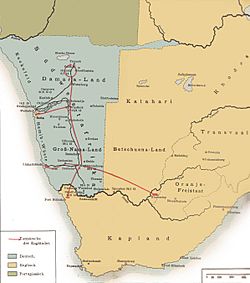 The South West Africa campaign in 1915 |
|||||||||
|
|||||||||
| Belligerents | |||||||||
|
|
|
||||||||
| Commanders and leaders | |||||||||
|
|||||||||
| Strength | |||||||||
| 67,000 South Africans 12,000 Portuguese |
3,000 Schutztruppe 7,000 German militia & settlers 500-600 Boer commandos |
||||||||
| Casualties and losses | |||||||||
|
Union of South Africa:
Portuguese Angola:
|
German South West Africa:
South African Republic:
|
||||||||
The South West Africa campaign was a military operation during World War I. It involved forces from the Union of South Africa taking control of German South West Africa. This happened at the very start of the war, from September 1914 to July 1915.
Contents
Why the Campaign Started
When World War I began in August 1914, leaders in South Africa knew their country shared a border with the German colony of German South West Africa. South African Prime Minister Louis Botha told the British government that South Africa could defend itself. He also said that South African forces could and would invade German South West Africa.
South African troops quickly gathered near the border in September 1914. They were led by General Henry Lukin and Lieutenant Colonel Manie Maritz. Soon after, another group of soldiers took control of the port of Lüderitz.
The news of the war reached German South West Africa on August 2, 1914. It came through radio messages from Germany, relayed through stations in Togo to the main radio station in Windhoek.
The Boer Revolt: A Challenge at Home
Many Boer people in South Africa felt sympathy for Germany. This was because Germany had supported the Boer republics during the Second Boer War just 12 years earlier. Lieutenant-Colonel Manie Maritz, who was leading South African forces near the German border, declared that parts of South Africa were now free from British control. He called on all white people to fight for a "Free and Independent South Africa."
Maritz and other high-ranking officers quickly gathered about 12,000 rebels. These rebels were ready to fight in what became known as the Boer revolt, or the Maritz rebellion.
The South African government declared a state of emergency on October 14, 1914. Forces loyal to the government, led by Generals Louis Botha and Jan Smuts, quickly put down the rebellion. Maritz was defeated on October 24 and fled to the Germans. The rebellion ended by early February 1915. The main Boer rebels were sent to prison and fined. However, they were released two years later, as Botha believed in bringing people together.
Fighting Between South African and German Forces
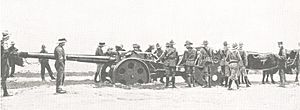
The first attempt by South Africa to invade German South West Africa from the south failed. This happened at the Battle of Sandfontein on September 26, 1914. German forces defeated the Union Defence Force (UDF). However, the surviving UDF troops were allowed to return to South Africa.
To stop South Africa's invasion plans, the Germans launched their own attack. The Battle of Kakamas took place on February 4, 1915. This was a fight for control of two river crossings over the Orange River. South African forces stopped the Germans from crossing the river.
By February 1915, with the Boer revolt under control, South Africa was ready to fully occupy the German territory. General Botha, a very experienced military leader, took charge of the invasion. He divided his forces into two groups. Smuts commanded the southern forces, while Botha directly led the northern forces.
Botha arrived at the coastal town of Swakopmund on February 11 to lead the northern group. He built up his invasion force at Walfish Bay (or Walvis Bay), a South African area along the coast. By March, he was ready to invade. His forces advanced from Swakopmund along the Swakop valley, following the railway line. They captured several towns, including Otjimbingwe, Karibib, and Okahandja. They entered the capital city, Windhuk, on May 5, 1915.
The Germans offered to surrender, but Botha refused their terms, and the war continued. On May 12, Botha declared martial law. He had cut the colony in half and divided his forces into four groups. These groups were led by Coen Brits, Lukin, Manie Botha, and Myburgh. Brits moved north, cutting off German forces in the interior from the coastal regions. The other three groups spread out to the northeast. Lukin followed the railway line to Tsumeb. Myburgh and Manie Botha advanced on Lukin's right side. These commanders, who had experience fighting in Boer commandos, moved very quickly.
The German forces in the northwest made a final stand at Otavi on July 1, but they were defeated. They surrendered at Khorab on July 9, 1915.
While these events happened in the north, Smuts landed with another South African force at the German colony's naval base at Luderitzbucht. After securing the town, Smuts moved inland, capturing Keetmanshoop on May 20. Here, he met up with two other groups that had crossed the border from South Africa. Smuts advanced north along the railway line. After two days of fighting, he captured Gibeon on May 26. The German forces in the south were forced to retreat north towards their capital. They were then caught by Botha's forces. Facing certain defeat, German Governor Seitz surrendered at Khorab, north of Windhoek, on July 9, 1915.
When the Germans provided a list of about 2,200 troops, Botha thought he had been tricked. He believed the Germans had 15,000 men. Victor Franke, the German commander, replied, "If we had 15,000 men then you wouldn't be here and we wouldn't be in this position."
Fighting Between German and Portuguese Forces
Before Germany and Portugal officially declared war in March 1916, their troops clashed several times. These fights happened on the border between German South West Africa and Portuguese Angola. The Germans won most of these battles. They managed to occupy the Humbe region in southern Angola. Portuguese control was restored just before the South African campaign defeated the Germans. The German attack into Angola also caused the native Ovambo people to revolt against Portuguese rule. This Ovambo Uprising was not fully stopped until after World War I ended.
What Happened Next
South Africa had 113 soldiers killed, 153 died from injuries or illness, and 263 were wounded. German forces had 103 killed, 890 taken prisoner, and lost 37 field guns and 22 machine guns. After defeating the Germans, South Africa occupied the colony. From 1919, South Africa managed it as a League of Nations mandate territory.
The South African government wanted to make South West Africa part of its own territory. However, it never officially did so. Still, it was treated like a "fifth province." The white minority in South West Africa had representatives in the South African Parliament. They also elected their own local government. The South African government also appointed the administrator for South West Africa, who had a lot of power.
After the League of Nations was replaced by the United Nations in 1946, South Africa refused to give up its control. The U.N. General Assembly then took away South Africa's right to govern the territory. In 1971, the International Court of Justice said that South Africa's continued control was illegal.


